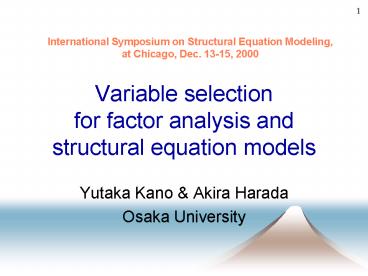Variable selection for factor analysis and structural equation models - PowerPoint PPT Presentation
1 / 30
Title:
Variable selection for factor analysis and structural equation models
Description:
Construct predicted chi-square for each one-variable-deleted model using the ... They will be useful for many situations including scale construction ... – PowerPoint PPT presentation
Number of Views:93
Avg rating:3.0/5.0
Title: Variable selection for factor analysis and structural equation models
1
Variable selection for factor analysis and
structural equation models
International Symposium on Structural Equation
Modeling, at Chicago, Dec. 13-15, 2000
- Yutaka Kano Akira Harada
- Osaka University
2
SEM has come to Japan
3
SEM in Japan
- Japanese Books
- Toyoda (1992). CSA with SAS
- Toyoda, et al. (1992). Exploring Causality
An Introduction to CSA - Kano (1997). CSA with Amos, Eqs and Lisrel
- Toyoda (1998). SEM Introductory Course
- Toyoda (editor, 1998). SEM Case Studies
- Yamamoto and Onodera (editor, 1999). CSA with
Amos - Toyoda (2000). SEM Advanced Course
4
SEM in Japan
- Tutorial Seminar (organized by academic
society) - Behaviormetric Society of Japan
- 1995, 1998, 2000
- Japan Statistical Society
- 1999
- Japan Psychological Association
- 1998
- Japanese Association of Educational Psychology
- 1999
5
SEM in my class(graduate course)
- What does SEM can do?
- Path analysis, CFA, Multiple indicator analysis
- How to create a program file
- How to read an output file
- Fit index, standardization, decomposition of
effects
6
- CFA and model modification
- Hypotheses on loadings
- Analysis of MTMM matrix
- LM and Wald tests
- MIMIC model
- Extended models
- Mean structure model
- Multi-sample analysis
- Multi-sample analysis with mean structure
- Model with binary independent variables
7
- Other useful models
- Analysis of experimental data with SEM
- Anove, Ancova, Manova, Latent mean analysis
- Longitudinal data and 3-mode data analysis
- Latent curve model
- Additive model, direct-product model, PARAFAC
- Other topics
- EFA versus CFA
- Cautionary notes on causal analysis
- Improper solution
- Variable selection
- Software
- LISREL, EQS, AMOS, CALIS, SEPATH, etc
8
Variable selection in factor analysis
- Exploratory analysis
- SEFA(Stepwise variable selection in EFA)
- http//koko15.hus.osaka-u.ac.jp/harada/sefa2001/s
tepwise/ - Confirmatory analysis
- SCoFA(Stepwise Confirmatory FA)
- http//koko16.hus.osaka-u.ac.jp/harada/scofa/inpu
t.html
9
Input Data
- What SEFA or SCoFA needs are
- correlation matrix
- sample size
- the number of variables
- the number of factors
- and Internet!!
10
Illustration
- Data
- 24 Psychological variables
- p24, n145, k4
- Joreskog(1978, Psychometrika)
- Analyzed it with EFA and CFA
- EFA.Chi-square227.14, P-value0.021
- CFA.Chi-square301.83, P-value0.001
11
WebPage for input
12
WebPage for input
13
24 Psychological variablesExploratory analysis
14
(No Transcript)
15
(No Transcript)
16
(No Transcript)
17
24 Psychological variablesConfirmatory analysis
18
Specify factor loading matrix
19
Original Model (p24)
20
P-values for 24 models
21
X3-deleted Model (p23)
22
X3,X11-deleted Model (p22)
23
Final results
- EFA
- Chi-square227.14(186), P-value0.021
- Delete X11
- Chi-square190.01(176), P-value0.107
- CFA
- Chi-square301.83(231), P-value0.001
- Delete X3, X11
- Chi-square220.17(189), P-value0.060
24
Theory of SEFA and SCoFA
- Obtain estimates for a current model
- Construct predicted chi-square for each
one-variable-deleted model using the estimates,
without tedious iterations - We will take a sort of LM approach
25
Known quantities and goal
26
Basic idea
We construct T02 as LM test
27
Final formula for T2
Note This is Brownes (Browne 1982) statistic of
goodness-of-fit using general estimates
28
Summary 1
- We introduced goodness-of-fit as a criteria for
variable selection in factor analysis - You can easily access the programs on the
internet - SEFA(Stepwise variable selection in EFA)
- http//koko15.hus.osaka-u.ac.jp/harada/sefa2001/s
tepwise/ - SCoFA(Stepwise Confirmatory FA)
- http//koko16.hus.osaka-u.ac.jp/harada/scofa/inpu
t.html
29
Summary 2
- They print predicted values of fit indices for
each one-variable-deleted model
one-variable-added models - Chi-square, GFI, AGFI, CFI, IFI, RMSEA
- They will be useful for many situations including
scale construction - High communality variables can be inconsistent
30
References for variable selection
- Kano, Y. (in press). Variable selection for
structural models. Journal of Statistical
Inference and Planning. - Kano, Y. and Harada, A. (2000). Stepwise
variable selection in factor analysis.
Psychometrika, 65, 7-22. - Kano, Y. and Ihara, M. (1994). Identification of
inconsistent variates in factor analysis.
Psychometrika, Vol.59, 5-20.































